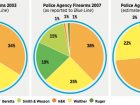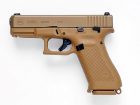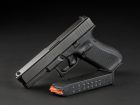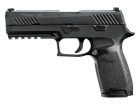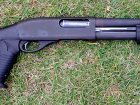
Features
Duty firearms 2018 – New trends in police and law enforcement guns and ammo
There is no magic bullet. There never was. The dream of the mystical firearm — with the “one-shot stop” capability that could instantly incapacitate a highly motivated individual bent on killing other human beings — was just that... a dream.
December 15, 2017 By Dave Brown

The firearms that will be issued by law enforcement agencies in Canada today and into the future are not that much different than what were issued a decade ago.
There have been certain evolutionary changes in the design of almost all police firearms since Blue Line’s last comprehensive cross-Canada Gun Survey in 2007, but there is little that is truly revolutionary. After all, a law enforcement firearm has only one function — to place an accurate shot deep enough into a vital area in order to stop a deadly threat as quickly, efficiently and effectively as possible. The longer a fight lasts, the greater the danger to the public, the officers involved and ultimately to the assailants themselves.
Most agencies in Canada are now issuing patrol carbines and some have switched one make of pistol for another, but the truly futuristic weapons we see on television always have one fatal flaw yet to be overcome — they are not able to be employed in a fraction of a second during a life-threatening situation by an averagely trained officer in order to instantly stop a deadly threat. This is why the top makes of pistols strapped to the hips of officers today, and the top makes of rifles and shotguns mounted to the front seats of patrol cars in Canada, are not that much different from the ones issued back in 2007.
If anything, ammunition choices have improved, training has become more dynamic and there is an increased understanding of the science of stress and incapacitation. There is also better recognition today that the only two factors that stop deadly threats are shot placement and shot penetration.
Here is an outline of what police and law enforcement officers will be carrying in 2018 and in the near future.
HANDGUNS
Glock
In 2007, Glock held 38 per cent of the police market in Canada. Ten years later, they are now used by 75 per cent of the agencies. (In the U.S. it is just slightly under 65 per cent.)
Canada’s second largest police agency, the Ontario Provincial Police, transitioned from the SIG P226 in .40 calibre to the Glock 17M in 9mm. They will be joined by another 11 agencies in Canada who have issued or will be issuing the new Glock 17M.
The 17M is the fifth generation of Glock’s mainstay pistol and what some would arguably call the first good-looking Glock handgun. Originally designed for the FBI contract, the 17M used most of the features of Glock’s Gen5 model, released in August 2017:
• No finger grooves on the frame,
• Stippled grips and interchangeable backstraps,
• Conventional rifling instead of polygonal rifling,
• Flared magazine well,
• Magazine cutout in the front face of the grip,
• New magazine floorplate design,
• Ambidextrous slide release,
• Smooth trigger face,
• Beveled forward edge of the slide,
• Double recoil spring system,
• New hardening process for slide and barrel (referred to as a DLC or diamond-like carbon finish).
In the U.S., in addition to numerous municipal and state police, the 17M has been chosen by the federal agencies such as the FBI, DEA, DOE, USPS, US Marshall Service and the Park Police.
Glock was also one of two finalists in the U.S. military XM17 Modular Handgun System trials to select a new joint service pistols for the U.S. Army, U.S. Air Force and U.S. Marines. The winner of the competition would become the M17 full-size and M18 compact pistols, designed to replace the existing Beretta M9 and SIG M11.
Tender requirements for the new pistol necessitated greater accuracy, accessory rails for various sighting and lighting devices, a modular design to accommodate various hand sizes and full ambidextrous controls.
Glock entered the competition with the Model 19 MHS compact pistol in 9mm Luger chambering, and Model 23 MHS compact pistol in .40 S&W. The Glock MHS pistols have the full size frames from the Model 17/22 and shorter slides from the 19/23. Glock added an ambidextrous manual safety and slide stop, and a lanyard ring on the rear of the grip.
Glock ultimately lost the XM17 competition to the SIG P320 pistol (see the “Factory Recall” sidebar at the end of this article) and is not planning on selling the MHS pistols on the law enforcement or civilian market, citing the manual safety was a one-off design requirement and would not become part of a production pistol.
Sig Sauer
The most popular Sig Sauer police handgun in Canada is the P226. The steel barrel and slide were combined with an aluminum alloy frame for a lightweight and durable handgun. More expensive than many of its competitors, it has now been replaced by many agencies in the U.S. with the brand-new polymer-frame P320 model.
Designed for the U.S. military Modular Handgun System pistol competition, the P320 has the same high bore line of the popular P226 but with a much more ergonomic frame and grip angle. It uses a stainless steel skeleton in a polymer skin, allowing the pistol to be adapted to a variety of frame sizes and calibres.
The P320 won the U.S. military XM17 pistol competition to become the new M17 joint service sidearm. Blue Line tests of the P320 demonstrated the excellent feel of the grip and very smooth trigger pull, but the high bore line resulted in more muzzle flip than a Glock. The forward centre of gravity also caused it to feel initially awkward in the hand, especially with a light attached to the forward frame rail.
Time will tell if the P320 — not without controversy — lives up to its expectations in military and law enforcement service.
Smith & Wesson
The S&W polymer-frame M&P pistol has been making serious inroads into the U.S. police market. It is now (or shortly will be) standard issue for recruits in many state and municipal police agencies, including Los Angeles Police Department, Los Angeles Sheriffs Department, Las Vegas Metro Police, Detroit Police Department and California Highway Patrol. Many other agencies have listed the M&P on their approved carry list.
In conversation with Smith & Wesson three years ago, Blue Line was told that the M&P was issued or listed by over 500 law enforcement agencies in North America. By 2018, that number may be almost triple.
Almost every agency in the U.S. who issued the previous full-size S&W handguns (4006, 5946, 4506, etc) have now transitioned to the M&P. Calibre choices in the U.S. are spread pretty evenly between 9mm, .40 and .45.
In Canada, the M&P is now standard issue for several agencies such as Peel Regional Police and Windsor Police Service.
Blue Line’s head-to-head tests of the M&P against other top contenders bear out the increasing reputation of the M&P line. I found the M&P to be 100 per cent reliable and ergonomics better than anything else on the market. An older-generation Glock 21 feels like holding a two-by-four in comparison to a M&P 45, and the SIG P226 feels like the wrong end of a baseball bat compared to the grip size of the M&P 9.
Early M&P triggers were horrendous, spawning the creation of high-quality aftermarket suppliers just to fix the trigger pull, but the latest second generation models have vastly improved triggers.
The introduction of a new generation of polymer-frame pistols does not make older, well-designed, all-steel handguns any less accurate or reliable. Canada’s largest police force, the RCMP, will continue to issue the S&W 5946 and 3913 models. There is no indication that a new model is imminent and RCMP members have assured Blue Line that supplies of both pistols and spare parts will not be a problem. ERT and K9 officers will continue to carry modified versions of the 5946 that remove the magazine disconnect.
Blue Line tests of the 5946 pistol showed that the solid feel, excellent sights and smooth trigger pull translated into an accurate, if heavy, handgun
Other makes
As predicted by Blue Line in 2007, Beretta has almost completely disappeared from the Canadian police market. Vancouver Police Department switched from Beretta to Sig and four other police agencies transitioned from Beretta to Glock, most of them citing quality control and customer service issues.
The sole agency of any size in Canada that issues the Beretta is Canada Border Service Agency (CBSA), with the new polymer-frame Beretta PX4 Storm pistol. In service reports show the pistol is reliable, but with spotty quality control, problems with magazine feed lips and prematurely wearing sights. CBSA management has been forced to issue new or rebuilt pistols to officers every three years and has extended the service life of the pistol by the simple expediency of not allowing many of its officers to carry handguns on duty.
Blue Line was a vocal supporter of the arming initiative for CBSA; former publisher Morley Lymburner and myself both appeared at House of Commons hearings in Ottawa to support giving law enforcement officers the tools they need to do their jobs. It will take time, as CBSA evolves, to happen.
Other makes in Canada include the Heckler & Koch P2000 issued by Correctional Service Canada (CSC) and the H&K P30 issued by Ontario Ministry of Natural Resources, replacing their previous H&K USP pistols.
AMMUNITION
Return to the 9mm Luger
Calibre debates will go on for years, but scientific tests performed by agencies such as the FBI, coupled with results from actual shooting incidents, show that the only two factors that stop assailants are shot placement and shot penetration. This is why there is an increasing recognition that the 9mm Luger, with modern bullet designs, can get the job done just as effectively as the slightly more powerful .40 S&W.
In 2007, police agencies were split almost equally between the two cartridges. In 2017, the numbers are significantly different; the 9mm Luger (also called the 9×19 Parabellum) is now being used by 80 per cent of all police and law enforcement agencies in Canada.
Advances in modern police ammunition means that the 9mm Luger cartridge, with the right bullet configuration, performs equally as well as the .40 S&W cartridge in both real-world shootings and scientific tests.
The 9mm Luger cartridge also has several advantages over the .40 S&W:
1. Less recoil means the 9mm is easier to train on, more conducive to practice and can result in faster follow-up shots on target when required. Proponents of the .40 will scoff, but the fact is that the .40 is not as much fun to shoot, nor as comfortable. When officers enjoy training, they will be more inclined to practice regularly.
2. The 9mm Luger has equal or greater accuracy than the .40 S&W. Agencies who transitioned from .40 to 9mm experienced no drop in accuracy and most report higher scores in training and qualifications. Historically, there is no documented situation where an assailant was stopped by a near miss from anything up to and including a .44 Magnum.
3. The 9mm Luger is easier on handguns. The cartridge is available in a variety of loads, all the way up to the more powerful +P+ load. In the .40 S&W world, there is no such thing as a +P load, simply because the .40 S&W is always a maximum pressure cartridge. This means the .40 battered the crap out of handguns, and service lives were shortened, and maintenance intervals and parts replacement costs were higher.
4. The 9mm Luger results in higher capacity, as much as two to three rounds for the same size frame. While this number may not be significant when you are talking 16 versus 18, one must acknowledge that if the best gunfight in the world is the one that never happens in the first place… the second best gunfight is to have lots of rounds when you need them the most.
5. Ammunition costs are lower for the 9mm. While price should not be the sole deciding factor in law enforcement handgun and ammunition selection, an agency needs to factor in the costs of not just duty ammunition but also large supplies of training and practice rounds.
The cartridge designed after the 1986 FBI murders in Miami-Dade County, Fla., was the right cartridge for the time but with modern bullet designs, the cost of the .40 in higher recoil, greater muzzle flash and more wear on handguns just does not pay off in better downrange or terminal performance.
HOLSTERS
Safariland
The overwhelming choice for duty holsters in Canada is Safariland. They have a well-earned reputation for quality, reliability, durability and ease of training. The few agencies that issued the Blackhawk SERPA holster have now mostly gone back to Safariland, a choice that we applaud.
In previous Blue Line head-to-head holster tests, we found the only advantages of the Blackhawk holster to be that they were cheap and could be purchased anywhere. But most agencies found that holsters bought for cheap (and practically at your local convenience store) are not necessarily the ones that stand up to the rigours of dynamic training plus daily shift work. We have seen parts literally fall off SERPA holsters during training sessions.
Our tests also showed that the release button placed almost directly over top of the trigger guard required a conscious effort to keep the finger out of the trigger guard on the draw stroke. Combine a very fast draw with the loss of feeling in the finger from a high-stress situation, and the result could be a higher likelihood of a negligent discharge.
RIFLES AND SHOTGUNS
Patrol carbines
The single biggest advancement in police weapons in Canada has been the introduction of the patrol carbine. Now found in nearly every cruiser in Canada, the carbine gives centre-of-mass accuracy out to as far away as 200 metres. When equipped with the modern electronic sight, the carbine is both incredibly fast and extremely accurate at distances much farther than handguns or even shotguns could hope to accurately achieve a disabling shot.
The most popular patrol carbine in Canada is the law enforcement version of the Colt Canada C8. Reviewed by Blue Line in February 2014, it is the semi-automatic version of the Canadian Forces carbine and is built to the very tough NATO D14 standards of manufacture and testing.
Winnipeg Police Service has started issuing the Daniel Defense carbine, made with a cold-hammer-forged barrel similar to the Colt Canada carbine.
While critics of police see the carbine as evidence of a “militarization” of the police, knowledgeable experts cite the increased accuracy of the carbine, reduced over-penetration capability of the modern .223 Remington cartridge and the ability to quickly neutralize deadly threats past 100 metres.
Police carbines are not military-style “assault rifles” because they have no full-automatic capability, but they are built to the same high standard as military firearms and by the same manufacturers to ensure instant reliability no matter the temperature or climate conditions.
Shotguns
While many agencies have replaced the shotgun with the patrol carbine, some are equipping street officers with both. This gives further use of force options. The versatile shotgun fills in the critical distance from seven to 25 metres and provides the ability to quickly and instantly neutralize a deadly threat at distances beyond the combat range of a handgun.
The most common police shotgun in Canada is the Remington 870 Police. Available in a variety of sight and barrel-length configurations, it is durable, reliable and very fast to fire multiple rounds when necessary.
A few agencies issue the Mossberg 590A1 shotgun. The 590A1 is the U.S. military version of the 500-series of Mossberg shotguns, and comes with a thick-walled barrel, metal trigger guard and steel frame-mounted safety.
Some police agencies are equipping their patrol vehicles with a double-gun rack that can accept both carbines and shotguns. Others are using single racks with replaceable inserts to carry both as required.
Police services that do not equip every vehicle with a carbine and use a single rack are finding problems when quickly switching from the short collapsible stock of the carbine to the full stock of the shotgun in the same mount.
In a Blue Line head-to-head test of the best in aftermarket stocks and accessories for the 870 Police, the best overall solution was the Mesa Tactical Urbino stock. It uses a fixed, shorter length-of-pull stock and a rubberized pistol grip that results in an overall length not much longer than an AR-style collapsible stock conversion. The Urbino stock can be used by officers large or small with equal ease and, unlike a collapsible stock conversion, does not bop longer-armed officers on the nose with every shot, nor does it catch facial hair in the joint between the stock tube and the sliding plastic stock. (Not fun. Trust me.)
Nearly as fast as a straight stock, the Urbino also renders full-house buckshot or slug rounds to almost a pleasure.
Future trends
It is hard to predict what will happen 10 years from now. I would speculate makes and models may be upgraded, but percentages will stay relatively stable in Canada. Until those futuristic weapons are designed that will quickly work in the middle of a real-life dynamic situation, the best gun in the world is the one you have in your hand when you need it the most. I am guessing it will probably be not that much different from the one on your hip right now.
Dave Brown is Blue Line’s firearms and police vehicle contributor. He is a tactical firearms trainer and consultant based in Winnipeg, Man. He can be reached at davebrown@blueline.ca.
Print this page
